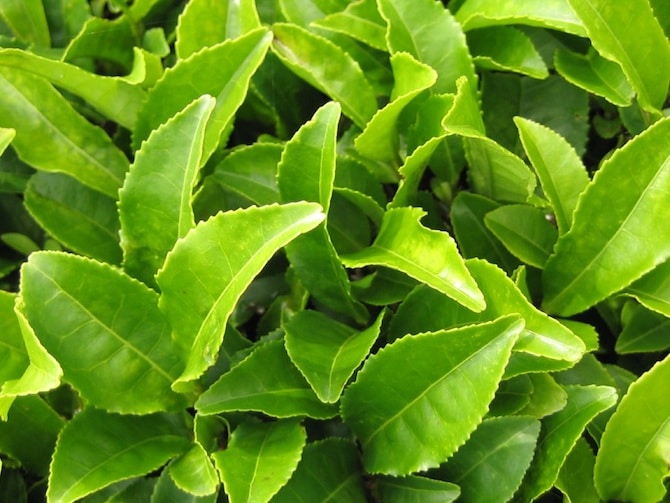
While Japan in General is known for its curative green tea culture, there is one place where the offerings are truly rich: Uji.
Located in the Kyoto Prefecture, just on the outskirts of the city of Kyoto, Uji’s plains and hillsides grow green tea in abundance, while its streets offer green tea ice cream, complimentary green tea tastings and green tea curry at every corner. The tea history of this city dates back to thirteenth century, when a Zen Monk named Eisai gave seeds to a local priest he had procured in Sung dynasty China — where green tea was highly regarded for its curative capabilities — to open a tea farm. Locals soon realized the conditions were perfect for planting green tea. On a recent trip to Kyoto, Japan, I had the chance to experience the green tea and other cultural offerings of Uji for myself, as well as artisan shops, traditional food, scenic views and one of the country’s most famous temples.
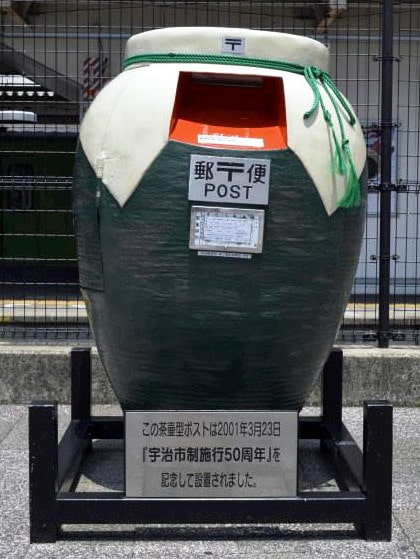
Uji: Logistics
To reach Uji, I take the train from my hotel in central Kyoto to Uji Station, immediately greeted by a post office box shaped like a green tea plant when I exit. If this isn’t a sign the area is obsessed with their green tea, I don’t know what is. I’m also immediately swept up in the fact Uji has much more of a countryside feel than Kyoto, a welcomed change of pace (although Kyoto isn’t overly fast-paced itself, especially compared to the cosmopolitan Tokyo).
My guide for the day is Moriwaki Michiko (moriwaki.michiko (at) gmail (dot) com), a certified English and Spanish speaking guide who’s also part of the National Japan Tour Guide Association. Note: Even without a guide it’s possible to enjoy this day trip from Kyoto’s city center, especially as there is a free-to-take easy-to-read map of the nearby streets right when you get off the train. That being said, you may have a hard time understanding everything and asking questions with nobody to interpret, which is why hiring a qualified bilingual local to lead you around is a smart idea.
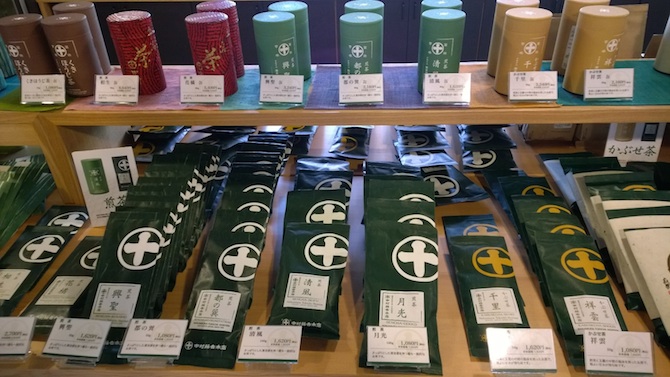
An expansive green tea selection at Nakamura Tokichi. Photo courtesy of Jessica Festa, taken with a Nokia Lumia Icon.
Green Tea Tasting
We begin our walk by crossing the street and making a slight right onto Ujibashi-dori Street, lined with bakeries, artisan shops and green tea tasting opportunities. Almost directly across the street is Nakamura Tokichi, serving tea since 1854, where you can lounge in a Japanese garden with misters to refresh your skin, savor green-tea infused treats, cakes and jellies, and have a free green tea tasting. They make a variety of teas of all different qualities so you have many options for sampling local culture through the palate — as well as saving your wallet.
The building is over 200 years old, with much of the traditional elements preserved and on display like Japanese artwork, straw flooring, fusuma sliding doors and tatami mats. A noren flutters softly outside the entrance welcoming you in, while across street can see them making pastries with natural local ingredients at Patisserie Yuji.
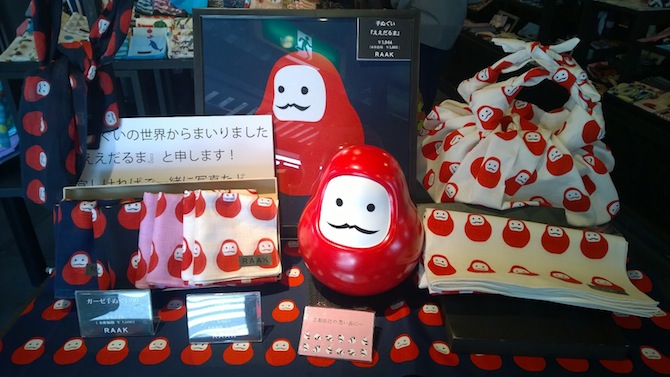
Daruma dolls at Eirakuya Collaboration. Photo courtesy of Jessica Festa, taken with a Nokia Lumia Icon.
Artisan Culture
Walk a little further up the street toward the water to Eirakuya Collaboration — open since 1615 — home to traditional Kyoto accessories and arts items. Here you can browse fans, purses and artwork depicting important festivals and symbols, cordial fabrics, daruma dolls (a symbol of determination, essentially a rolling head that always goes back to its original position no matter how you push it), frogs (a symbol of a good trip and happy return that one can also keep in their purse for wealth).
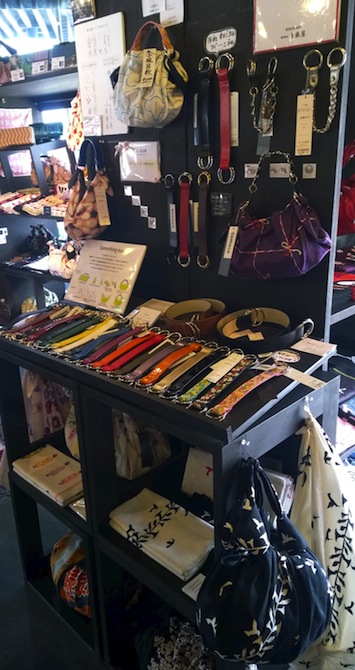
Something Eco. Photo courtesy of Jessica Festa, taken with a Nokia Lumia Icon.
One of my favorite parts of the shop was called a brand called Something Eco (Someco) that allows you to create your own purse by wrapping beautiful fabrics in an origami style and attaching a wrist band, which also means the fabrics can be used for other purposes later.
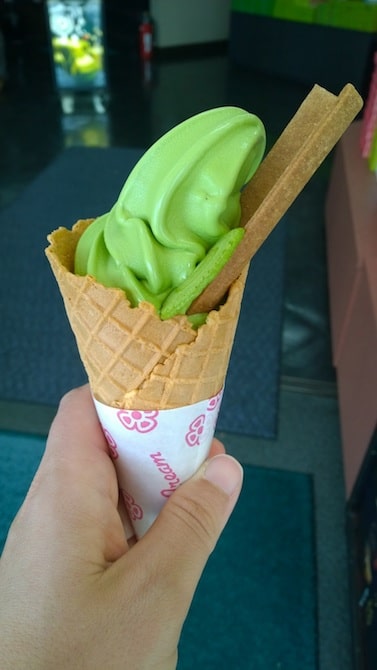
Green tea ice cream. Photo courtesy of Jessica Festa, taken with a Nokia Lumia Icon.
Next, we walk to Byodin Omote Sando Street and made a right, immediately coming upon more opportunities to savor local crafts and green tea flavors — as well as, according to Moriwaki, Uji’s best green tea ice cream at Masuda Tea Store Kyoto. While I can’t compare as I haven’t tried the other shops’ offerings, I will tell you I literally dreamed about the dripping green cone later that night. The sweet treat is made by combining egg, sugar and milk and cooking on low heat, before cooling the mixture and adding in matcha green tea and whipped heavy cream and freezing.
For green tea liqueur and Uji Matcha Curry, Ito Kyu Emon is a must-visit, also offering complimentary green tea samplings.
Getting to lunch requires a waterside walk along the Uji River on the Path of Ajirogi, although English signs ensure you don’t lose your way. The path is paved, lined with shops and plenty of places to sit and take in the ambient bridges, boats and water in a peaceful space.

Colorful bento box from Kyouyouri Tatsumiya Restuarant. Photo courtesy of Jessica Festa, taken with a Nokia Lumia Icon.
When the river path forks we head downward until we reach out final destination: Kyouryouri Tatsumiya Restaurant (Tel: (0774) 21- 3131), a traditional eatery where the menu highlight is Ujimaru Bento (about $30). While what the bento contains changes daily, you can expect to find 30 different small tastings of dishes like deep fried sea bream, pumpkin tofu topped with okra and taro with green tea sauce wrapped in bamboo bark — all served with a side of ground green tea-seasoned rice, miso soup and local green tea. You’ll have to take off your shoes upon entering the restaurant — so wearing socks is a good idea — and will dine in a private room with low tables, sliding shoji doors and, is you’re lucky, views of the Uji River.
If you haven’t had enough green tea, the city offers a Japanese tea ceremony experience at the Taiho-an (about $5, 10am-4pm seven days a week, 2 Ugi-Ttogawa), a sukiya-style wooden house with a tin roof. Here you’ll savor wagashi and matcha and learn how the Japanese tea ceremony is about more than just drinking tea, but also providing guests with a beautiful and meticulous experience, as you never know when life will be taken from you.
Much of the philosophy behind the tea ceremony seems to bear samurai in mind, as the most important people are seated in the “safest seats” — the ones farthest from the door and the least likely to get shredded by a sword — and are given the best bowls for drinking from. During my experience, the host, Ms. Sakatani, explains (in Japanese, translated by my guide) the meaning of the tea ceremony and the room’s decor.
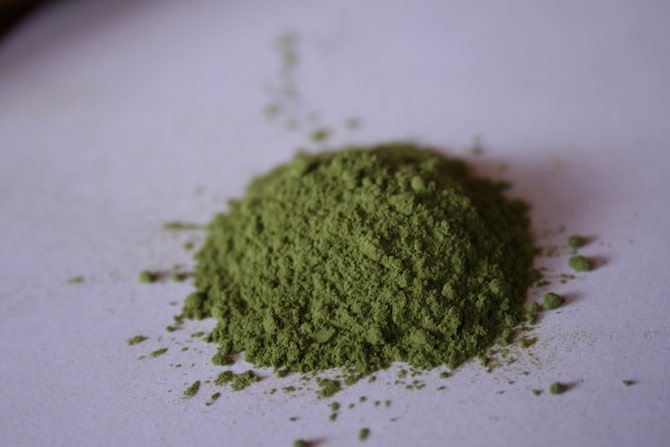
Matcha green tea powder. Photo courtesy of Akuppa John Wigham.
We’re first asked to remove our shoes before entering the building and kneel around a tatami mat. A team of Japanese women in kimonos bring out plates of wagashi — seasonally shaped to represent the summer hydrangea flower (in autumn, you’ll more likely see a maple leaf sweet). The reason for the sugary treat is that matcha green tea is very bitter, so the sweetness prepares the mouth.
Once we’re served the tea, bowing as the giant bowl is placed in front of us, we take it in our right hand, place it on our left palm, admire the design on the ceramic and turn it clockwise as to not put our mouth on the picture when sipping. We’re instructed to take notice the bubbles on the surface of the tea, allowing ourselves to slurp them if we’d like. When finished, we turn the bowl counterclockwise and admire the bowl’s design again. Mine is made locally and depicts the Uji Bridge, another reminder of these talented and proud locals.
As we sip, sandlewood incense adorned with mini drink umbrella, again for summer, burns to purify the space, while a seasonal flower arrangement showcases the colors of June in a cormorant fishing basket, a sport that takes place in Uji from mid-June through August. Once the bowls are empty, the women clear them, exchanging bows as appreciation and disappearing through the shoji doors, made out of thin Japanese paper to look like stone walls in a Japanese castle. It’s amazing how every tiny detail is thought out, hoping to encourage visual and experiential enjoyment right down to the pot the matcha is made in. It is shaped like a nutmeg with a lid sculpted with pine tree leafs underneath and handles resembling eggplants.

Buddha. Photo courtesy of stephanie carter. Note: Byodo-In Temple did not allow photos for media use. To see a photos of the temple, click here.
Once we’re full of bento and tea, we experience a true highlight of Uji, especially in terms of spirituality: Byodo-In Temple, a UNESCO World Heritage Site. This is actually the third place of worship I’ve visited that day — Kiyomizu Dera Temple and Fushimi Inari Taisha (Shinto shrine) were also on the itinerary — and I’ve come to realize that Japan’s temples and shrines aren’t just composed of elaborate pagodas, colorful structures and enormous torii gates, but also experiences to make wishes come true, enhance your life and explore nature.
Byodo-In Temple was built in 1052 by the Regent, Fujiwara no Yorimichi, and today home is home to the Hoshokan Museum displaying artifacts discovered from excavations on site; a garden that’s a designated National Historic Site and Place of Scenic Beauty, inspired by gardens from the classic Heian period; and Phoenix Hall — home to 52 Worshiping Bodhisattava statues on clouds as well as the famous Amida Buddha and paintings showing Amida’s nine grades of descent. The temple is one of Japan’s few remaining examples of Heian architecture, and is home to a number of National Treasures that will help you truly understand the country’s heritage. Not to be missed is simply standing in front of the Phoenix House, admiring the Phoenix’ atop the building that symbolize revival and the reflection of the building in the surrounding pond, meant to represent the sea and even incorporating a man-made “tide.”

Uji Bridge View. Photo courtesy of Jessica Festa, taken with a Nokia Lumia Icon.
Before heading back to the city of Kyoto the group stops to admire the view of the Uji River from the Uji Bridge, originally built in 646 by Doto, a priest of Gango Temple in Nara. It is one of the oldest bridges in the Japan, although due to a fire had to be reconstructed numerous times, most recently in 1996. Regardless, standing on it makes me feel like I’m planting my feet on a piece of history, while the surrounding water and mountain views provide the perfect backdrop for the day’s final bite of culture in Uji.
Still hungry for heritage? Just beside the bridge is Tsûen Teashop, operating since 1160 and showcasing a great example of machiya architecture. Kyoto is proud of its preserved history and tradition — one of the few Japanese cities not affected by air raids in the mid 1940s. Because of this, many buildings and businesses have been preserved. Now in its eleventh generation of the Tsûen family, the shop is recognized by Kyoto prefecture as a Cultural Property, with a history of serving tea to important people such as Shogun Ashikaga Yoshimasa and Japan’s second “great unifier” Toyotomi Hideyoshi. Even if you aren’t craving tea or are short on time, it’s a must-have experience to sit in this historical space for some time.
Top green tea photo credit: Green tea. Photo courtesy of Joel Burslem.

Jessica Festa is the editor of the travel sites Jessie on a Journey (http://jessieonajourney.com) and Epicure & Culture (http://epicureandculture.com). Along with blogging at We Blog The World, her byline has appeared in publications like Huffington Post, Gadling, Fodor’s, Travel + Escape, Matador, Viator, The Culture-Ist and many others. After getting her BA/MA in Communication from the State University of New York at Albany, she realized she wasn’t really to stop backpacking and made travel her full time job. Some of her most memorable experiences include studying abroad in Sydney, teaching English in Thailand, doing orphanage work in Ghana, hiking her way through South America and traveling solo through Europe. She has a passion for backpacking, adventure, hiking, wine and getting off the beaten path.








